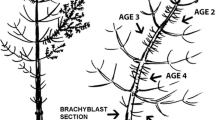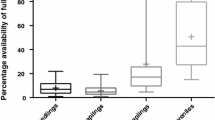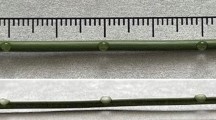Summary
Ethylene produced by different needle age classes representing natural populations of two ponderosa pine varieties [Pinus ponderosa var. arizonica (Engelm.) Shaw and var. ponderosa Dougl. ex Laws.] and Jeffery pine (Pinus jeffreyi Grev. and Balf.) was characterized using mercuric perchlorate traps. All populations contained individual trees which were either symptomatic or asymptomatic with respect to visible ozone injury. Ethylene production by different needle age classes was also characterized in P. ponderosa var. ponderosa seedlings grown in open top ozone fumigation chambers. Older age class needles produce significantly (P>0.05) more ethylene than younger age class needles. Needles of both P. ponderosa var. ponderosa and P. jeffreyi exhibiting ozone injury in the field produced significantly (P>0.05) higher levels of ethylene than asymptomatic conspecific trees. Seedlings exposed to the highest level of ozone in the fumigation study produced the highest levels of ethylene, followed by fumigation with medium and low ozone concentrations and carbon filtered air. These data indicate that the measurement of ethylene in conifer needles, as a measure of stress, needs to be calibrated for needle age class. It also suggests that the sensitivity of a tree to ozone injury may be regulated by the inherent ability of the individual to produce ethylene.
Similar content being viewed by others
References
Abeles FB (1973) Ethylene in plant biology. Academic Press, New York
Bergmann F, Scholz F (1987) The impact of air pollution on the genetic structure of Norway spruce. Silvae Genet 36: 80–83
Chen YM, Wellburn AR (1989) Enhanced ethylene emissions from Red and Norway spruce exposed to acidic mists. Plant Physiol 91: 357–361
Elstner EF (1987) Ozone and ethylene stress. Nature 328: 482
Hogsett WE, Tingey DT, Holman SR (1985) A programmable exposure control system for determination of the effects of pollutant exposure regimes on plant growth. Atmos Environ 19: 1135–1149
Hogsett WE, Tingey DT, Hendricks C, Rossi D (1989) Sensitivity of western conifers to SO2 and seasonal interaction of acid fog and ozone. In: Olson RK, Lefohn AS (eds) Effects of air pollution on western forests. Air and Waste Management Association, Pittsburgh, pp 469–491
Houston DB, Stairs GR (1973) Genetic control of sulfur dioxide and ozone tolerance in eastern white pine. For Sci 19: 267–271
Kao CH, Yang SF (1982) Light inhibition of the conversion of 1-aminocyclopropane-1-carboxycilic acid to ethylene in leaves is mediated through carbon dioxide. Planta 155: 261–266
Karnosky D (1977) Evidence for genetic control of response to sulfur dioxide and ozone in Populus tremuloides. Can J For Res 7: 437–440
Mehlhorn H, Wellburn AR (1987) Stress ethylene formation determines plant sensitivity to ozone. Nature 327: 417–418
Mehlhorn H, Francis BJ, Wellburn AR (1989) Prediction of the probability of forest decline damage to Norway spruce using three simple site-independent diagnostic parameters. New Phytol 110: 525–534
Miller PR, Parmeter JR, Jr, Taylor OC, Cardiff EA (1963) Ozone injury to the foliage of Pinus ponderosa. Phytopathology 53: 1072–1077
Mirov NT (1967) The genus Pinus. Ronald Press, New York, pp 370–375
Nelson ND, Isebrands JG, Rietveld WJ (1980) Ethylene loss from the gas phase of container-seal systems. Physiol Plant 48: 509–511
Pedersen BS, Cahill TA (1989) Ozone at a remote, high altitude site in Sequoia National Park, California. In: Olson RK, Lefohn AS (eds) Effects of air pollution on western forests. Air and Waste Management Association, Pittsburgh, pp 207–220
Telewski FW (1990) Growth, wood density, and ethylene production in response to mechanical perturbation in Pinus taeda. Can J For Res 20: 1277–1282
Telewski FW, Jaffe MJ (1986) Thigmomorphogenesis: the role of ethylene in the response of Pinus taeda and Abies fraseri to mechanical perturbation. Physiol Plant 66: 211–218
Tingey DT (1980) Stress ethylene production — a measure of plant response to stress. Hortic Sci 15: 630–633
Tingey DT (1989) Bioindicators in air pollution research — applications and constraints. In: Woodwell GM (ed) Biologic markers of air pollution stress and damage in forests. National Academy Press, Washington, D.C., pp 73–80
Tingey DT, Standley C, Field FW (1976) Stress ethylene evolution: a measure of ozone effects on plants. Atmos Environ 10: 969–974
Wolfenden J, Robinson DC, Cape JN, Paterson IS, Francis BJ, Mehlhorn H, Wellburn AR (1988) Use of carotenoid ratios, ethylene emissions and buffer capacities for the early diagnosis of forest decline. New Phytol 109: 85–95
Author information
Authors and Affiliations
Rights and permissions
About this article
Cite this article
Telewski, F.W. Ethylene production by different age class ponderosa and Jeffery pine needles as related to ozone exposure and visible injury. Trees 6, 195–198 (1992). https://doi.org/10.1007/BF00224335
Received:
Accepted:
Issue Date:
DOI: https://doi.org/10.1007/BF00224335




